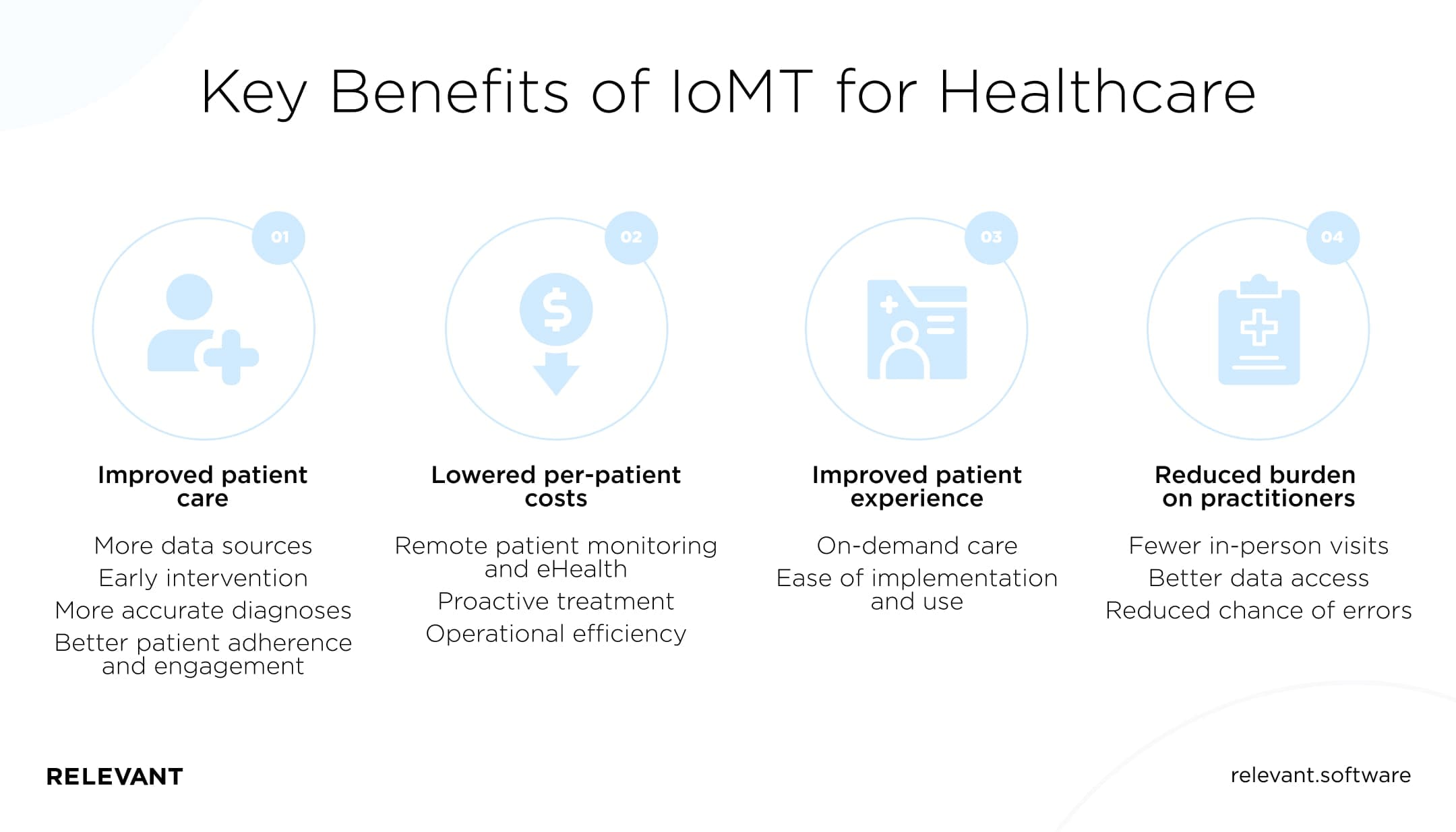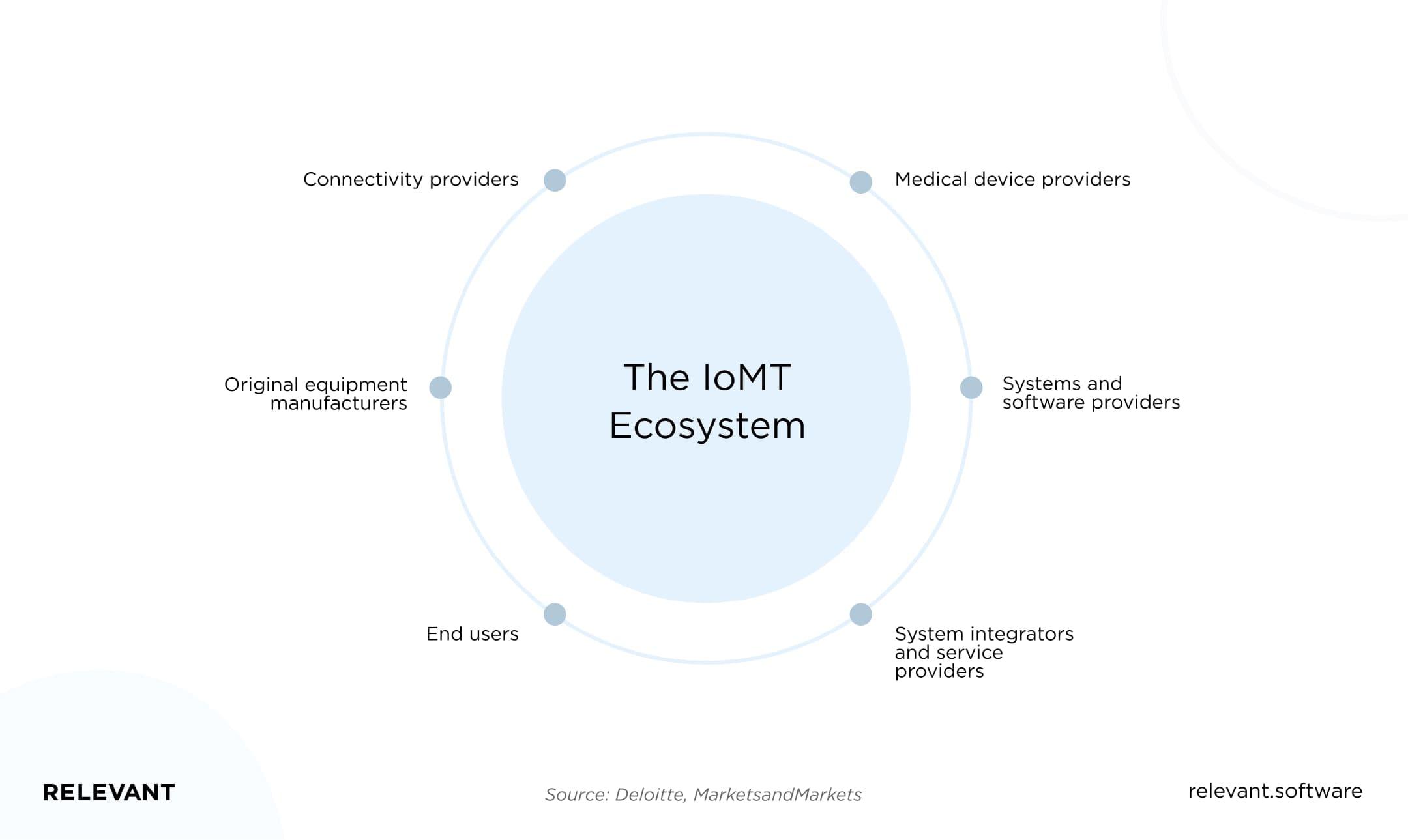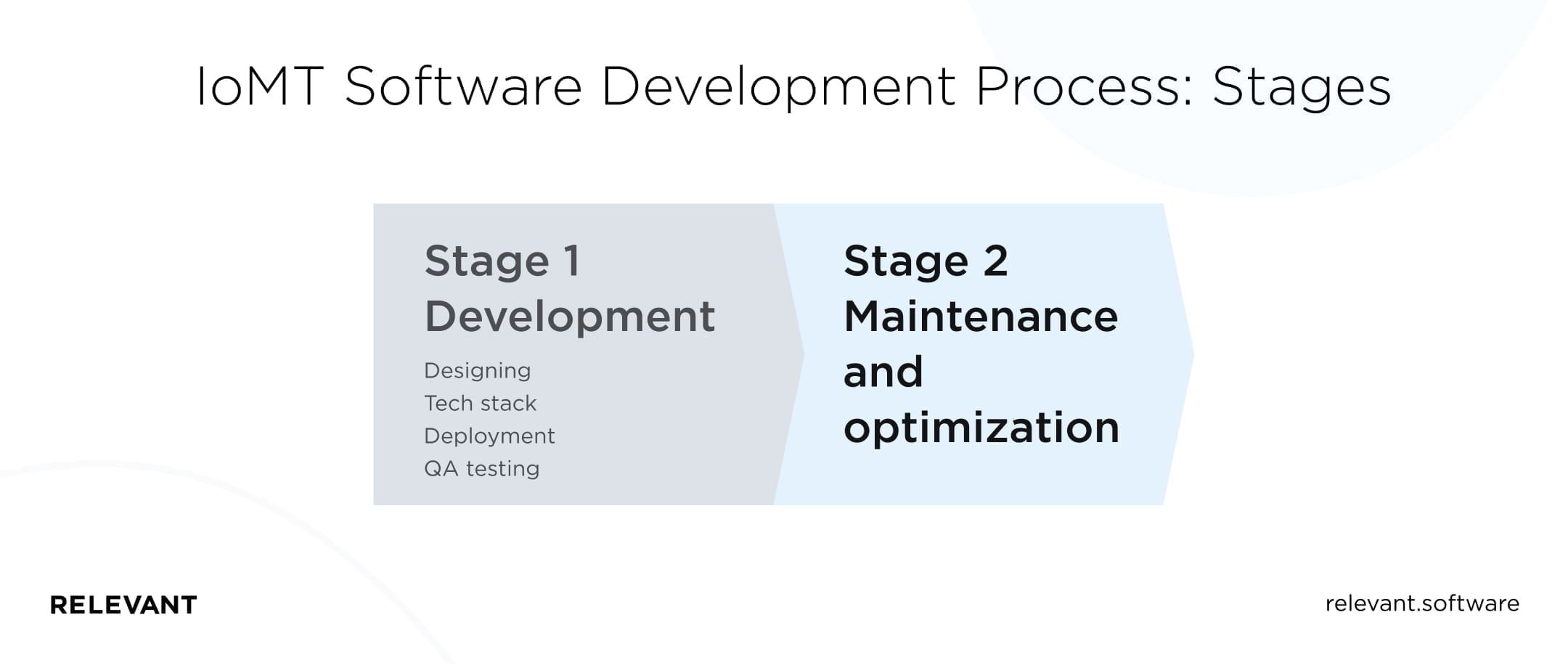How IoMT (Internet of Medical Things) Transforms Healthcare Industry
Updated: September 20, 2023
The Internet of Medical Things (IoMT) is one of the fastest-growing markets, with a stunning expected annual growth rate of 24.4% by 2026. Looking at how IoMT helps healthcare improve patient care and reduce per-patient costs, it’s not surprising that providers are adopting this technology at full tilt.
Not there yet? Don’t fret. With our eight years of hands-on experience in software development, including medtech and IoT, Relevant knows how to help you jump on the IoMT train. In this brief guide to IoMT development services, we’ll share the knowledge and tips we’ve accumulated over the years.

We provide companies with senior tech talent and product development expertise to build world-class software. Let's talk about how we can help you.
Contact usContinue reading to discover IoMT benefits for the healthcare market, the most common use cases, and a proven way to develop an effective software solution your users will love.
Table of Contents
What’s IoMT?
The IoMT stands for the Internet of Medical Things—an infrastructure of wirelessly connected devices, systems, software applications, and other technology solutions used in healthcare. Connected with each other through a cloud platform, they collect, process, and analyze heaps of data in real-time.
IoMT isn’t new technology, but it is booming. In 2015 there were 4.5 billion IoT devices in healthcare, while now this number may have reached 20-30 billion. An average US hospital room has 15-20 connected devices, such as wearables and heart monitors.

Benefits of IoMT for healthcare
The IoMT and the technologies behind it, such as cloud computing and artificial intelligence (AI), benefit healthcare more and more each year. Some of the most prominent advantages are listed below.

Improved patient care
Improved patient care results in better treatment outcomes, and here’s how IoMT helps:
- More data sources. Connected technologies offer providers additional sources of patient data. For example, data from digestible pills with nanosensors can report whether and when patients take their medications.
- Early intervention. Wearable devices for remote patient monitoring (RPM) can alert doctors about symptom changes far before something minor becomes a more severe problem. This is crucial for chronic diseases that require round-the-clock symptom monitoring.
- More accurate diagnoses. The IoMT not only provides new data but also consolidates and analyzes data from different sources. This gives practitioners better insight into patient health, allowing them to make more informed decisions when diagnosing patients and prescribing treatment.
- Better patient adherence and engagement. Medication reminder apps motivate patients to take medications regularly, and wearable devices like smartwatches and belts motivate patients to track their vitals and educate them about their symptoms and conditions.
Lowered per-patient costs
Deloitte estimates that US spending on healthcare will reach $8.3 trillion by 2040. However, medical IoT (IoMT) solutions have the potential to reduce this number, and here’s how:
- Remote patient monitoring and eHealth. Instead of seeing noncritical patients at hospitals, providers can now monitor them at home and receive real-time data about their symptoms. IoMT also enables remote appointments for routine check-ups, decreasing the number of patient clinic visits.
- Proactive treatment. IoMT applications and devices lead to earlier intervention and better patient medication adherence. This, in turn, reduces treatment costs, as doctors can prevent more severe conditions and hospitalization.
- Operational efficiency. IoMT consolidates patient data while also providing real-time tracking of a hospital’s entire infrastructure, including equipment and staff. This helps to optimize workflow and supply management, thus reducing waste by allocating resources to areas that need them the most.
Improved patient experience
As healthcare shifts toward value-based care, the patient experience becomes even more important. The IoMT improves patient outcomes, reduces patient visits, and facilitates communication between doctors and patients. Let’s have a closer look at this.
- On-demand care. Telehealth and other IoMT solutions allow patients to access qualified care when they need it, regardless of location or ability to travel.
- Ease of implementation and use. IoMT devices are easy for patients to transmit data quickly and can even be fun for patients to use. In addition, they can help patients better understand their symptoms via built-in AI technologies like chatbots.
Reduced burden on practitioners
IoMT solutions help fight the burnout experienced by almost 80% of practitioners, and here’s how:
- Fewer in-person visits. Remote patient monitoring and telehealth reduce the number of patient clinic visits.
- Better data access. A busy doctor can check all patient records on his or her tablet immediately after data is recorded by a nurse or a medical device.
- Reduced chance of errors. IoMT solutions improve data analysis, while AI tools ensure that no critical information is overlooked.
Considering the numerous benefits that IoMT solutions bring, it’s not surprising that it’s one of the leading technology trends in the medical industry. Next, we’ll have a closer look at the IoMT software market.
The IoMT software market: Where do we stand now?
According to the AllTheResearch report, the global IoMT market will reach $254.2 billion in 2026, 5.7 times more than in 2018 ($44.6 billion). Real-time monitoring applications account for the biggest market share now, though tracking and alert applications are likely to grow even faster than they.
Several factors are fueling the rise of IoMT software:
- COVID-19 pandemic
- Rapid progress in digitalization
- Aging population—the percentage of people aged 65 years or over is set to double by 2050, reaching 1.5 billion
- Demand pressures from people suffering from chronic diseases
- Public demand for more convenient, personalized medical services and mobile technologies (mHealth)
- Growing healthcare spending
The industry is shifting toward more proactive, patient-centered, and digitally-enabled smart healthcare. This requires a wide range of medical devices and applications to help monitor, diagnose, and treat health conditions. In 2018, half a million medical technologies were already available on the healthcare market, ranging from sensors and monitoring devices to patient management software. The number of medical devices that generate, collect, or analyze health data continues to grow, resulting in the creation of a robust IoMT ecosystem (see the image below).

The IoMT ecosystem brings together medical devices and mobile applications, multisource data, processes (monitoring and care delivering), and people (patients, providers, payers). It generates and consolidates measurable information that improves treatment speed and accuracy, while also enabling remote patient monitoring and home care. The IoMT has many application types, as you’ll see below.
Applications of the Internet of Medical Things
IoMT technologies reduce per-patient costs and optimize hospital workflows, so it’s no wonder their application in the medical sector is constantly growing. Typically, IoMT solutions fall under one of five categories:
- Point-of-care devices: diagnostic tools used outside of laboratories
- Smart pills: small electronic devices in the form of a capsule with sensor indicators or built-in video cameras
- Medical alert systems: medical devices that call for help in case of an emergency
- Wearables: devices, like smartwatches, with in-built sensors that consumers or clinicians use to monitor health indicators
- In-hospital devices: MRIs, X-rays, and other medical equipment or devices used in hospitals for monitoring patients, staff, and managing supply
Next, we examine some popular use cases of IoMT.
Example use cases of IoMT
Healthcare creates new IoMT use cases every day, so it’s hard to keep track of them all. But here are a few examples that have become commonplace.

Remote patient monitoring
IoMT tracks heart rate, respiratory rate, temperature, blood pressure, and other vitals in real time. Along with physiological indicators, practitioners can also monitor psychological parameters remotely in patients with conditions like depression or paranoia.
Chronic disease monitoring
IoMT enables 24/7 monitoring of patients with chronic conditions and can alert practitioners when medical intervention is required. This includes having patients wear special sensor devices and surgically implanting sensors under the skin (for example, for monitoring glucose levels).
Health assistance and emergency aid
IoMT systems can work like virtual assistants that predict health issues, educate patients about their symptoms, advise on diet and lifestyle, and alert medical staff of emergencies. In some cases, they can even contain a remotely activated first aid kit to relieve acute symptoms.
Activity and sleep tracking
IoMT devices can monitor fitness-related metrics and sleep quality, providing users with motivation and recommendations for how to improve results.
Clinical infrastructure management
Trackers can notify the hospital about the location of medical devices across the hospital and warn when supplies are running low. In addition, IoMT can monitor electricity and other resource consumption, alert about unauthorized access, and monitor air contamination in rooms.
What types of IoMT software can you develop?
Internet of medical things solution development is a broad term that includes many types of software. Here are the most common examples:
- he and chronic disease tracking apps
- Medication reminders
- AI-empowered IoT big data solutions for data analytics and visualization
- Assisted living apps with built-in AI chatbots and virtual assistants
- Software for location tracking (patients, employees, and hospital assets)
- Telehealth software
- Wireless nurse calling systems
- Queue management systems
- Software for doctor and nurse schedules and staffing optimization
- Climate control and smart room lightning apps

Software functionality will largely depend on your specific case, so the best way to bring together all needed features and avoid possible IoMT vulnerabilities is to hire a software development team to build a custom solution.
How to build IoMT solutions: Based on an example of a chronic disease tracking app
A chronic disease tracking app serves as a disease management tool for both practitioners and patients. Usually, it tracks vitals and provides this data to practitioners. It can encourage patients to adhere to their medication plan, make healthier lifestyle choices, and can help them get medical aid if needed.
Below, we provide an example of how to develop an IoMT app, using a chronic disease tracker as an example.
Must-have features of a chronic disease tracking app
A tracker app should meet the same requirements common to most medical apps:
- User-friendly interface
- Flexibility and scalability
- High availability
- Security (cyber protection and data security)
- Frequent updates
- Third-party integration
Meeting these requirements will ensure that your app is easy to integrate, modify, and use, while also making sure it’s secure and works with no failures.
The app must also have specific features, which usually fall under one of three categories: tracking, reporting, and actions.
- Automated health data recording (symptoms, treatment history, etc.)
- Streamlined care coordination and communication with medical staff (live chats, emergency alerts, etc.)
- Tools for online consultation with practitioners
- Search capabilities (for example, search for and display names of nearby doctors, their location, and their availability)
- Medication reminders
- Diet and lifestyle reminders, recommendations, and encouragement
- Preventive healthcare tools for patient education and encouragement
This list is not comprehensive; depending on the specific case and app purpose, the list may vary. A professional team of developers experienced in providing IoMT application development services can help create a solution for you.
Composition of the development team
A typical team includes a project manager, business analyst, UX/UI designer, IoMT developers (backend and frontend), and QA engineers. If your project size is large, you’ll also need a DevOps engineer, a technical writer, and a product manager in your team.
In some cases, you may need very specialized developers, so partner up with an IoMT software development company that can offer you a wide variety of services and tech stacks.
Stages of the development process
The whole development process can be roughly broken into two stages:

Stage 1. Development
IoMT development can be lengthy, taking from 2-3 weeks for a simple medication tracker to up to a year for a rich-featured chronic disease tracking app. The development stage includes:
- Designing. The design phase involves wireframing and prototyping. When the design phase is complete, you should clearly understand the software architecture and have user stories and style guides at hand.
- Tech stack. The next step is deciding on a tech stack, which will largely depend on your IoMT project requirements, including your budget and timeframe.
- Deployment. A chronic disease tracking app should be a highly available and scalable system; you don’t want to have to release massive updates too frequently. Instead, aim for a more flexible automated deployment approach that allows you to apply small changes as needed.
- QA testing. Software testing ensures that the app meets your requirements and runs flawlessly. For better efficacy, we recommend applying both manual and automated testing strategies.
Stage 2. Maintenance and optimization
After releasing the app, you can collect user feedback and get a better understanding of what the app might be lacking. During this phase, you can add or remove features, fix bugs, and scale the app. Once you scale it to the desired size, you can start optimizing cost, performance, availability, bulk operations, and resources the app uses.
Cost
The final cost of IoT mobile apps depends on many factors, including the app’s functionality, complexity, size, and even the geographical location of your IoMT development team. For example, these are IoT developer salaries in different countries:
- US: $113,088/year
- Ukraine: $45,000/year
- UK: $69,887/year
- Netherlands: $73,151/year
- Germany: $74,421/year
If you want the best ratio of expertise to cost, we recommend outsourcing to Ukraine. Along with lower rates and global recognition in tech development, Ukraine also has an optimal geographic location—its time zone ensures convenient communication for both EU and US clients.
Why you should outsource your IoMT solution development
Outsourcing IoMT software development gives you access to a large talent pool of talented experts who can complete your projects in the most efficient timeline possible, avoiding hidden pitfalls and common mistakes.
Most healthcare providers outsource custom IoMT software development instead of building an in-house development team or buying a ready-made app. Here’s why:
- Outsourced specialists are more experienced as they deal with businesses of all sizes and industries
- Outsourced specialists keep track of new technologies and tools and align with the best development practices
- Outsourced development is more cost-effective than building an in-house team
- An outsourced team can be built in a few weeks, which is crucial if you need a fast release to market

With an outsourced team, you can build a secure app to address specific challenges and fully integrate it into your hospital IT system, no matter how complex it is.
Why Relevant Software?
If you decide to develop an IoMT solution from scratch, choosing a reliable partner to work with should be your primary concern. Luckily, you don’t have to look far—Relevant has just the right expertise at the crossroads of healthcare and IoT app development.
With over eight years of full-stack development experience, we offer you full-service IoT software solutions just like we did it for these projects:
- Össur: We helped build mobile apps for knee brace selection, measuring, and ordering.
- Sensor Innovation: We improved their existing system for environmental tracking and emergency alerting at industrial and residential sites.
- Airthings: We created a dashboard for data from indoor radon monitoring devices and implemented a monitoring and alerting system.
Whatever your project is, don’t hesitate to contact our experts. Together we can build an IoMT app that your users will love.
Summary
The pandemic, an aging population, increased spending, and higher patient expectations force the healthcare industry to either continue putting out fires or to pioneer innovation. As the industry shifts toward digitally enabled care, the number of medical devices and amount of data continue to grow, fueling the rise of IoMT solution development.
A properly built application can curb many provider and patient woes. So joining forces with a professional and reliable IoMT development company like Relevant is vital for project success.
Want to give your project a jump start? Get in touch to discuss details and share your ideas with us.
FAQ
What are some examples of IoT uses in healthcare?
The most common examples of IoT in healthcare are fitness-tracking watches and other wearables that monitor health parameters. Medical IoT devices also include software for data analytics, heart and glucose monitors, sensor-enabled hospital beds, and even pills.
Why is IoMT the future of healthcare?
IoMT brings many benefits to healthcare. Along with reducing per-patient cost and improving operation efficacy in hospitals, it also contributes to the higher quality of treatment and a better patient experience. IoMT aligns with new industry approaches and facilitates the industry’s shift toward value-based care.
What is the best way to develop an IoMT solution?
To develop an effective IoMT software solution, you need to partner with a reliable software development vendor that can provide end-to-end services and a wide range of tech stacks. The provider should have hands-on experience in medtech and IoT. Opt for outsourcing to a dedicated development team that will alleviate headaches while staying under your
How much does it cost to build an IoMT solution?
The cost varies, depending on project requirements, complexity, size, functionality, tech stack, and even development speed. Outsourcing to Ukraine provides an optimal price/quality ratio. The hourly rate of Ukrainian developers averages from $25 to $70.
Our core services:
Do you want a price estimate for your project?
Do you know that we helped 200+ companies build web/mobile apps and scale dev teams?
Let's talk about your engineering needs.
Write to us











